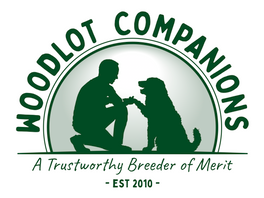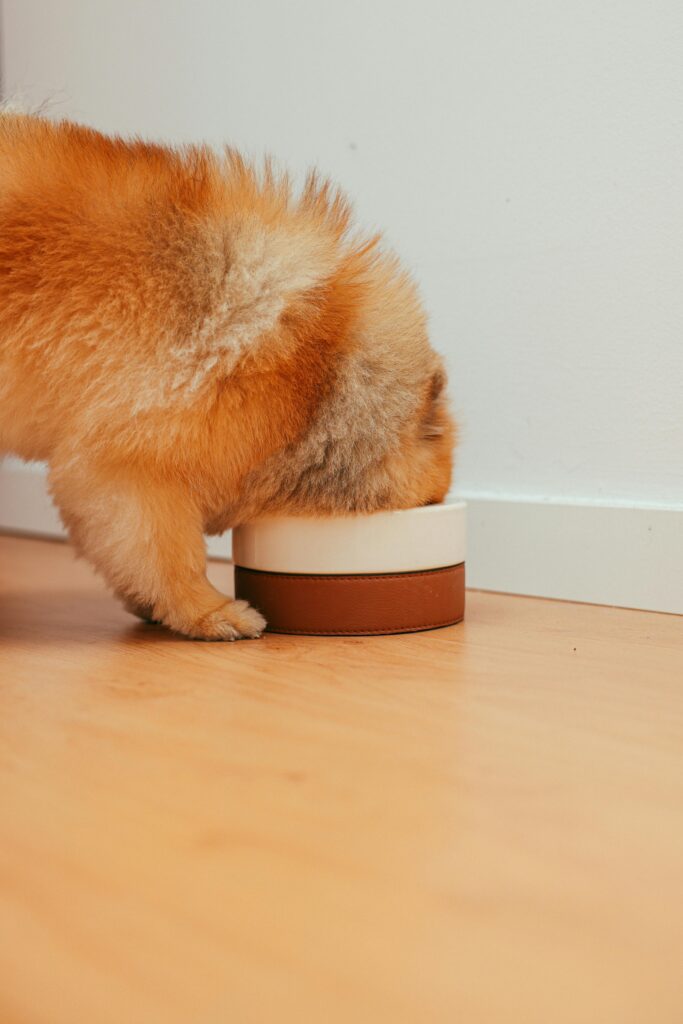How frequently should I feed my puppy?
While your puppy has been in our care here at Woodlot Companions, there have been many changes to his or her feeding patterns and a schedules as they have gone to feeding exclusively with their mother’s milk to transitioning to kibble during their weening period, to eating exclusively kibble by the time they are ready to go to their forever homes at 8 weeks of age.
Because of so much rapid growth and transition, your puppy has been eating and drinking on a grazing schedule along with all of their littermates. In other words- there is no schedule because they eat when they are hungry and the amount of food consumed is directly correlated with when they intuitively feel full.
There are a few reasons we do this.
1) it keeps rivalry and food competition/scarcity to a minimum. There may still be 1-2 siblings in a litter who hog the food, however there’s still plenty to go around even if your puppy has to wait their turn between feedings of the more naturally dominant siblings.
- It is important to keep feeding schedules neutral. Since your puppy has weened from drinking their moms milk all day, we couldn’t ween as successfully if the puppies went on a timed feeding schedule. transitioning a puppy to kibble takes time and is a big adjustment to not only their tastebuds, but their teeth and developing instincts as well.
- Keeping a graze-style feeding schedule also helps your puppy adjust to a scheduled feeding time in their forever homes- no matter which time zone they end up in or lifestyle of their new family they need to adapt to.
Grazing vs. scheduled feeding
You may want to keep your puppy on a grazing schedule and let them eat when they feel like it throughout the day. However for some families it just isn’t realistic between managing schedules for the entire household. Keeping your puppy on a schedule helps get them in a routine with the entire family and creating daily structure also helps them along in their potty training as well.
Your puppy is versatile and adaptive. Feed him or her 2-3 times per day and work their feeding schedule into a timeframe that works for everyone in the family.
How much food does my puppy need to eat?
If you purchased your puppy from Woodlot Companions your puppy has been eating Nutrisource puppy food, and will be fed a specific type of food according to the breed size. Your puppy may not want to eat when it first arrives to your home which is completely normal, however growing puppies will need between 1.5-3 cups of food depending on their size and breed. You should always refer to the dog food manufacturer’s guide for amount of food based off of the weight and age of you dog. This is especially important to pay attention to if you choose to transition your new furry friend’s food to a different brand or variety of food since each each brand has their own feeding guidelines based off of nutritional and caloric content.
How do you transition my puppy’s food to a different brand or type of food?
Many of our buyers already have dogs in their home or have preferences to different brands of food based on their experience raising dogs. Your puppy will come with a little bit of starter food, but if you already have your existing dog(s) on a particular brand- get the puppy version of the same brand to keep everyone in the house eating the same type of food. Use the food provided to you to help transition your puppy into the new food of choice. The transition should take 4-7 days and needs to be done at a pace that prevents bloat or other side effects to their digestive system. There are several ways to transition your puppy, but this is a very common way to do it:
Day 1: give 3 parts of their kibble (nutrisource) to 1 part of their new food at each feeding
Day 2: repeat day 1 feeding to keep the initial transition as gentle as possible.
Day 3: give 2 parts nutrisource to 1 part new kibble at each feeding
Day 4: give 1 part nutrisource to 1 part new kibble
Day 5: give 2 parts new kibble to 1 part old kibble
Day 6: give 100% new kibble
If your puppy is showing signs of struggling through the transition- slow down the process by repeating days in the transition. Make sure you are aware of the signs of bloat- which can happen by switching your puppy’s food too quickly.
How much water does my puppy need to drink?
While your puppy has been in our care at Woodlot Companions, it’s watering schedule has been the same as their feeding schedule and have been allowed to drink as much or as little as they want.
However, when your puppy first arrives being extra thirsty is normal. You will need to regulate how much you allow him or her to drink as they can consume too much which can cause them to puke or put unwanted pressure on their kidneys and bladder. Start with just a couple of cups of water every few hours to help get their entire digestive system back on track without adding to the transitional stresses with the goal of getting them back on a self-regulated schedule. Their instincts kick back in for appropriate water intake when their traveling ‘survival mode’ dissipates.
If you have further questions about food transitioning, other techniques, or other questions about your first 48 hours with your puppy– please check out our blog that addresses many of the common questions we get when you first bring your fur baby home or call us. We are happy to assist you in getting your new family member adjusted as quickly as possible!



